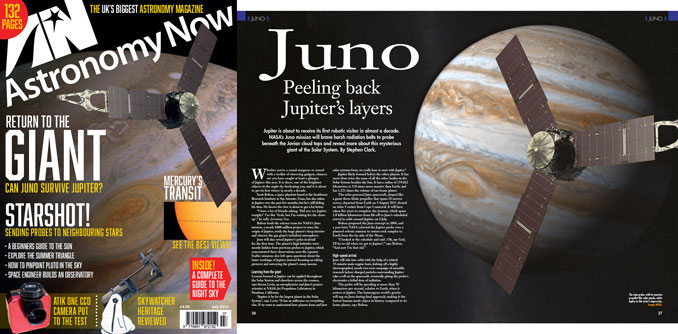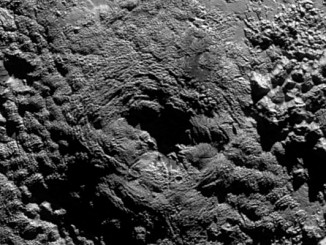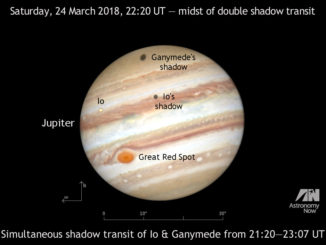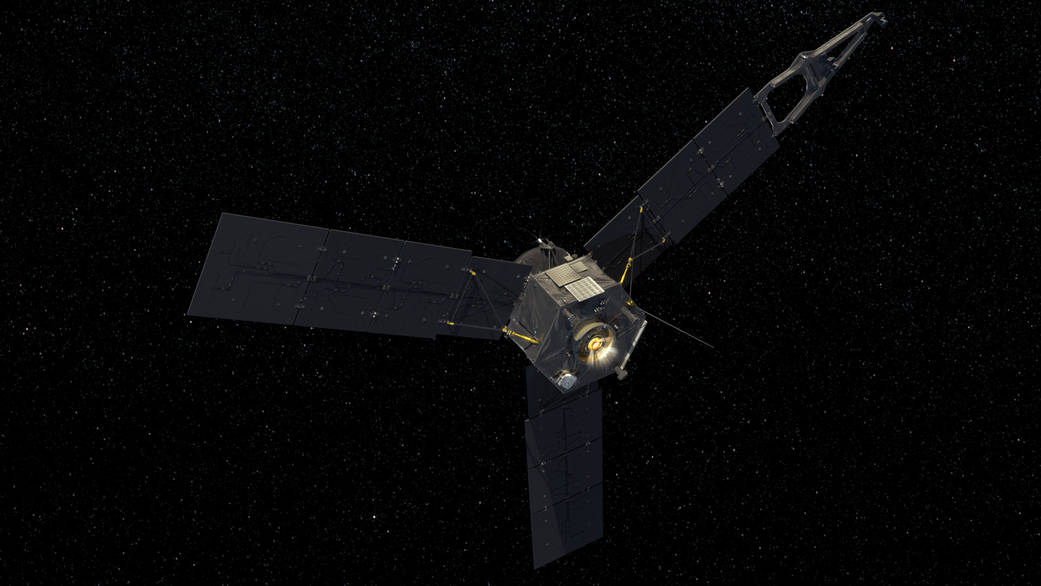
Ground controllers pressurised the Juno spacecraft’s propulsion system on Tuesday in preparation for a 5 July rocket firing by the probe’s UK-made rocket engine that will steer the spinning, solar-powered robot into orbit around Jupiter.
Kicking off more than 20 months observing Jupiter’s atmosphere and magnetic field, Juno is poised to become the second spacecraft to ever orbit the Solar System’s king planet, and the first since NASA’s Galileo orbiter ended its mission in 2003.
Juno’s Leros 1b main engine, designed and built by Moog-ISP in Westcott, Buckinghamshire, is gearing up for a make-or-break 35-minute firing to steer the spacecraft into a wide multi-million kilometre ellipse around Jupiter. Confirmation of the burn’s success is expected around 0353 GMT 5 July.
Pointing roughly in Juno’s direction of travel as the spacecraft spins up to 5 rpm, the engine will produce 645 newtons of thrust and consume a mix of hydrazine and nitrogen tetroxide. The toxic chemicals spontaneously combust when contacting each other, permitting the engine to generate thrust when Juno’s computer commands propellant valves to open.
The goal of the burn is to change Juno’s speed by 542 metres per second, the exact value required for Jupiter’s immense gravity to tug the spacecraft into a looping, oval-shaped 53.5-day orbit.
Juno will have one shot at the burn as it passes over Jupiter’s north pole and within 4,667 kilometres of its swirling, banded cloud tops, nearly 10 times closer than any previous mission.
Engineers calculated the engine must fire at least 20 minutes or so for Juno to be captured into any orbit around Jupiter, and 35 minutes to reach the targeted trajectory, according to Rick Nybakken, the mission’s project manager at NASA’s Jet Propulsion Laboratory.
The Leros 1b engine aboard Juno ignited twice in 2012 to adjust the spacecraft’s course, aiming the probe for a flyby of Earth in October 2013, using the planet’s gravity to slingshot toward Jupiter. The engine also briefly fired for a few seconds each year to flush contaminants out of the propulsion system.
“We know how to set up the propulsion system,” Nybakken said. “We know how the engine performs. The only thing new here is how the main engine performs, and the spacecraft performs, in Jupiter’s intense radiation environment.”
Juno’s single main engine is similar to liquid-fueled orbit-raising thrusters flown on many communications satellites. More than 70 Leros engines have flown in space, and most of them boosted telecom platforms from elliptical post-launch drop-off orbits to their final operating stations in geostationary orbit about 35,786 kilometres above Earth’s equator.
The engine design also has a history in interplanetary spaceflight.
Leros 1b engines successfully steered NASA’s Messenger mission into orbit around Mercury in 2011, helped get the Mars Global Surveyor and Mars Odyssey orbiters to the red planet, and flew on the NEAR Shoemaker spacecraft that became the first probe to orbit and land on an asteroid.
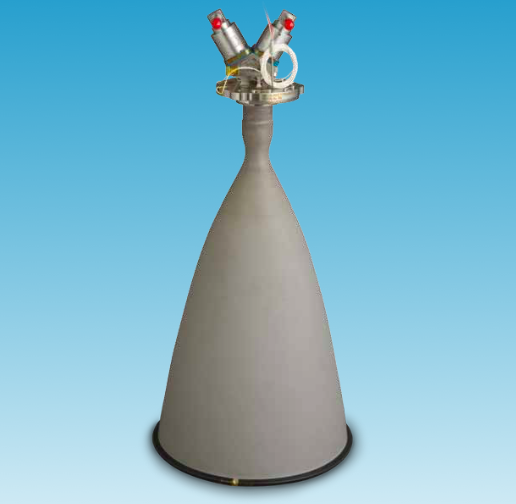
Ground controllers opened a micrometeoroid shield covering the engine 20 June, and engineers warmed up Juno’s high-pressure helium tanks Monday before pressurizing the orbiter’s propulsion system Tuesday. A member of Juno’s team confirmed the events occurred as planned.
Juno switched off its science instruments Wednesday as attention focuses on the 5 July orbit insertion manoeuvre.
The spacecraft is scheduled to start its Jupiter arrival sequence Thursday and run on autopilot through next week’s engine burn.
“It will be completely hands-off from that point,” said Jeff Lewis, Juno flight operations lead engineer at Lockheed Martin, which built the spacecraft and uplinks commands to the probe at an operations center near Denver.
It takes 48 minutes for a radio signal to travel one way between Earth and Jupiter, so real-time commanding is impossible.
“The spacecraft has to be pretty smart and pretty autonomous,” Lewis said. “There’s a lot of on-board fault detection, so it can detect faults and take care of itself.”
Without a successful insertion burn, there is no mission, so software engineers programmed Juno to do away with much of its conservative safety logic just for the 5 July arrival. If something fails or radiation zaps an electronic component, Juno will attempt to reboot and immediately resume the engine firing instead of going into safe mode and radioing Earth for help.
The so-called “auto restart” feature is a safeguard against the potential of a relatively minor fault ruining the mission, Nybakken said.
“For instance, if the radiation causes the computer to reset and the engine stops, it’s not designed to just protect the spacecraft,” Nybakken said. “It’s designed, for this one portion of the mission, to restart the burn.”
Juno’s on-board navigation is also smart enough to tweak the duration of the burn as it happens, incorporating data on the engine’s mixture ratio and performance, Lewis said.
Even if the navigation system runs into trouble, he said, Juno’s computer has a timer to turn off the engine at a prescribed time to ensure the burn does not run long.
But Juno is going into an unexplored realm, with its entire $1.1 billion mission riding on the outcome of Monday’s maneuver.
Juno will brush by Jupiter’s dangerous radiation belts on the way in Monday, with its most sensitive electronics wrapped inside a titanium vault designed to repel most impacts by high-energy particles that could damage the orbiter’s computers.
“We go in sort of like a dive bomber,” said Scott Bolton, an astrophysicist at the Southwest Research Institute who leads Juno’s science team. “We go in really fast and get out fast. That speed itself is really hazardous, and we’re also spinning. We’re this giant solar array spacecraft cartwheeling through this incredible magnetic field and radiation belt, so it’s a little bit scary.”
Juno will repeat its close-up encounters with Jupiter, called “perijoves” by orbital dynamicists, 36 more times before it plunges into the planet’s atmosphere for a destructive finale in February 2018. On each flyby, Juno will collect data on Jupiter’s magnetic and gravity fields, investigate the planet’s enigmatic interior, and take pictures, all while subjecting itself to the solar system’s most dangerous environment outside the sun.
But the arrival carries even more risk with the whole mission at stake.
“I think the Jupiter Orbit Insertion is the second highest risk (of the mission, after launch),” Bolton said. “Everything is riding on it. This spacecraft is very complex. This was a great challenge. We are going literally where no one has gone before.”
Email the author.
Follow Stephen Clark on Twitter: @StephenClark1.
Find out more about the Juno mission in the July issue of Astronomy Now. Get your copy in the shops or order online. Or subscribe today and never miss an issue.

